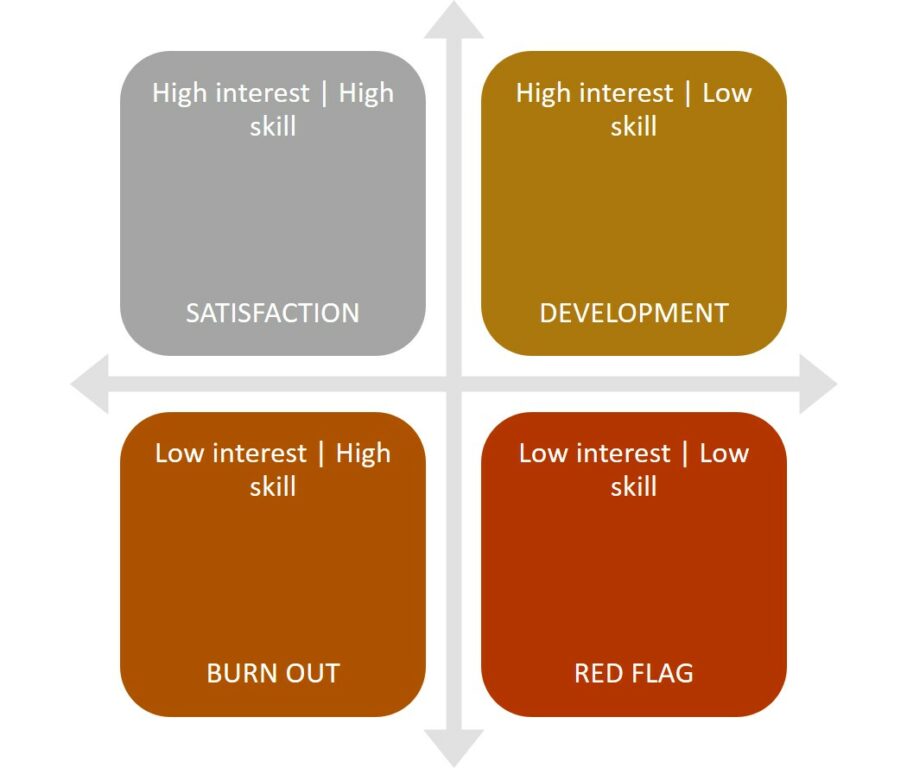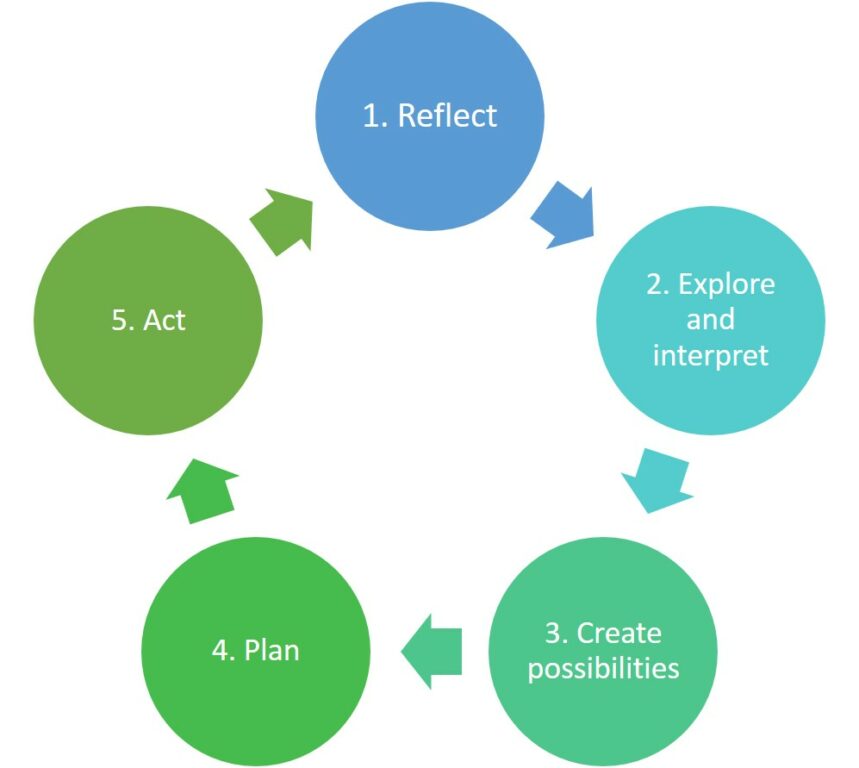If we were to ask you to list all the words that describe how you feel about your career, or how you view it, do you think there would be more positive words than negative?
Often, we get caught in the trap of thinking we have little or no control over our career, that we’re hostage to the current economic climate, employment opportunities and others’ decisions. To a certain degree these elements have an impact, but they don’t need to have complete control over our career satisfaction.
If we understand some of the reasons why we don’t feel satisfied in our career, this can provide the first step to addressing some of the simple issues that have arisen over time that fester into seeds of discontent. The quadrant below can be a useful tool in identifying the specific elements of your current role/or career which give you satisfaction; areas in which you’d like to be developed; those skills that you’re good at but really don’t find interesting or rewarding; and the danger zone of being out of your depth. Once you’ve worked through this you’ll have some specific details on which to focus your energies.

It’s certainly worth considering factors such as:
- Your own and your employer’s expectations
- Your relationships with your colleagues
- Your cultural and values fit within the organisation
- Your growth and advancement opportunities
- How you spend the bulk of your day and if you are interested in this aspect of the work and skilled to complete it
- Whether you have an opportunity to be innovative and actively contribute to the overall outcomes of the organisation
- How long you’ve been in this role or at this company
- Whether you can showcase your skills and abilities
You’ll see from this list much of our sense of career satisfaction is subjective and based on our perceptions of the situation.
One of the fundamental challenges of achieving career satisfaction has to do with how long you’ve been in a role. If you’ve worked for the same organisation for several years, earned a promotion, developed new skills and knowledge and are recognised for your contribution; it’s easy to maintain career satisfaction. The difficulty arises when, regardless of how long you’ve been at a company, there are limited opportunities for growth and development, or advancement and reward. Often when we perceive a lack of opportunity, we become complacent and resentful. Our interest in the role is reduced and we become bored and dissatisfied.
However, rather than giving all the power to whatever is happening ‘out there’ we do have control over our actions, behaviours, attitudes, beliefs and choices. This control is no small thing! If our career satisfaction is based on our perceptions of aspects in our careers, we can work at adjusting those perceptions and be proactive in creating opportunities.
Using Kolb’s Action Learning Model as a framework, we’d recommend you work through the following stages in order to have some proactive input into building your career satisfaction.

Step 1: reflect
Reflect upon yourself and ask yourself some focus questions, such as:
- What are my best skills, and why?
- What are my worst skills, and why?
- Personal values?
- Short term and long term goals?
- What do I seek and what do I try to avoid? Why?
- What’s my preferred work style?
- What’s my preferred management style?
- What’s my preferred communication style?
- How do I view teams and my contribution to them?
- Am I a leader and what type am I or do I want to be?
- What excites and motivates me?
- What are my strengths and how can I best use these?
Step 2: explore and interpret
This stage is all about how we perceive and feel our situation. Much of our motivation comes from what drives us to engage in the world the way we do. These motivations include beliefs and values, culture, family, view of others and the world. Much of this relates to the ‘why’ of our lives and interactions. When reflecting, delve a little deeper into why that may be important to you or why you would try to avoid it.
For example:
- Does your current role in your organisation fit with how you view the world in terms of corporate social responsibility?
- Do your values around work-life balance and being highly engaged and committed when at match your current role and organisation?
- What is your company’s environmental footprint and is that important or relevant to you?
- Do they stand for diversity and how do they live it? Is this something you are conscious of or care about?
These are the type of questions that need to explore at this point. Much of your satisfaction or dissatisfaction may arise based on these subjective elements of your career.
Step 3: create possibilities
View the big picture or blue sky of possibilities and how you might achieve or use them to build your career satisfaction. Your skills might need to be showcased or developed to move to the next stage of your career, but opportunities to develop or exhibit your skills also keeps you engaged and boredom at bay.
Looking for or even requesting to be part of projects, secondments, pilot new initiatives (especially if they are your initiatives) are ways to indicate that you want advancement or growth in your role. Your proactive approach is often seen very positively as many managers believe their staff need to take responsibility for their own development. What courses might you study, what training could you undertake, again from your own initiative, rather than expecting your employer to pay for it? Is there someone at work who you can shadow or who can coach you? Mentees and mentors alike need others who they can learn from.
Step 4: plan
Once you’ve done some blue sky thinking it’s time to focus on one or two possibilities to get things moving. The possibilities need to align with your self-reflection, your perceptions and values that you’ve identified in stage 2. You might also find some synergies between this process and your career goal setting as discussed in a previous article. Now would be a good time to revisit that process too.
The plan based on your possibilities needs to incorporate specifics of long and short term benefits, needs, resources and challenges. It’s best if you document or chart these specifics to help formulate a logical sequence of steps to achieve your plan. You’ll also be able to gauge if your plan and its options are realistic within your current organisation. There can also be some benefit of linking this plan to your performance goals for the year. But most importantly the plan needs to be flexible enough to adapt to new information, new circumstances but sound enough that is has a time frame, is measurable and is progressive.
Step 5: act
Although there is enormous value in the first four stages of this model, if you don’t step out of your current comfort or complacency zone nothing will change. It is up to you to act upon your plan to achieve the career satisfaction you deserve. Do the easiest actions first and build upon these giving yourself time to adjust and reflect upon what difference has occurred and how you feel about your career as a result.
Be mindful of how these actions impact others. If the actions have risks attached, then make sure you’ve considered these risks. Have conversations, ask lots of questions, use your networks to get a range of perspectives, but the key is that you can proactively influence your own career satisfaction. A word of caution, keep the plan flexible, keep your eyes and ears open to change going on around you so you can adapt. Although it’s good to keep your overall goal in mind, do be conscious of others and circumstances.
Remember, focus your energies on what you can control and build opportunities for yourself. Be mindful of what you can influence and create your own career satisfaction.


